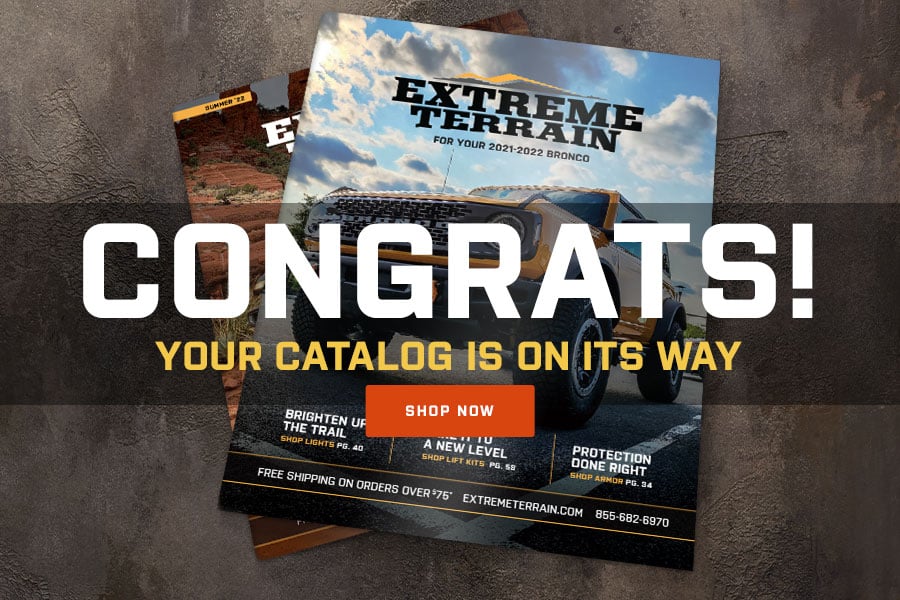

How to Install a Rough Country 4 in. X-Series Lift Kit w/ Shocks on your 2007-2014 Wrangler JK 4 Door
Installation Time
1 days
Tools Required
- 10mm Wrench
- 21mm Wrench
- 18mm Wrench
- 18mm Socket
- 19mm Wrench
- Reciprocating Saw
- 5/8" Wrench
- 21mm Socket
- Jack Stand
- 7/16" Wrench
- 9/16" Wrench
- 9/16" Socket
- 13/16" Socket
- Jack
- Grinder
- 13/32" Drill Bit
- Drill
- 19mm DeepWell Socket
- 7/8" Wrench

Shop Parts in this Guide
PRODUCT USE INFORMATION
As a general rule, the taller a vehicle is, the easier it will roll. Seat belts and shoulder harnesses should be worn at all times. Avoid situations where a side rollover may occur. Rough Country makes no claims regarding lifting devices and excludes any and all implied claims. We will not be responsible for any product that is altered. This 4” suspension system was developed using a 35X12.50X17 tire with 4.5” to 4.75” of back spacing on aftermarket wheels. Stock wheels can be used with this kit with up to a 35x12.5 tire, but different tire manufactures designs may result in a tire width that could result in contact with the lower control arm and/or front sway bar link in a sharp turn. Please consult with your tire and wheel expert before purchasing. Also note that if wider tires are desired, offset wheels will be required. If question exist we will be happy to answer any questions concerning the design, function, and correct use of our products by calling 1-800-222-7023.
IMPORTANT NOTES : Upon completing the install of this kit the draglink must be adjusted to center the steering wheel BEFORE the vehicle is driven. Failure to do so will cause a computer error, odd handling, and poor performance.
On Automatic equipped vehicles; due to use of an oversize driveshaft from the factory and inadequate factory clearance it may be possible for the front driveshaft to come in contact with the automatic transmission pan tearing the factory boot and rubbing on the shaft. Generally this occurs during heavy articulation when front sway bar links are disconnected and longer shocks are installed. If this is found to occur, the proper procedure would be to replace the oversize factory shaft with an aftermarket smaller diameter shaft to increase clearance between the transmission and front driveshaft. Rough Country does offer this driveshaft if needed.
Additionally on 2012 Models, additional exhaust modification on the passenger side crossover pipe will be required for adequate clearance on the front driveshaft.
NOTICE TO DEALER AND VEHICLE OWNER
Any vehicle equipped with any Rough Country product should have a “Warning to Driver” decal installed on the inside of the windshield or on the vehicle’s dash. The decal should act as a constant reminder for whoever is operating the vehicle of its unique handling characteristics.
INSTALLING DEALER - it is your responsibility to install the warning decal and forward these installation instructions on to the vehicle owner for review. These instructions should be kept in the vehicle for its service
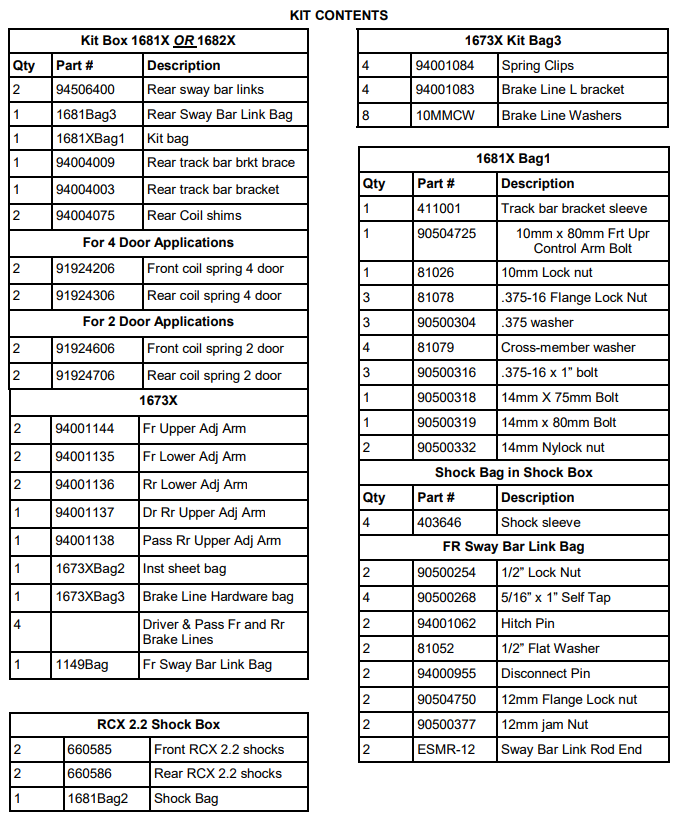
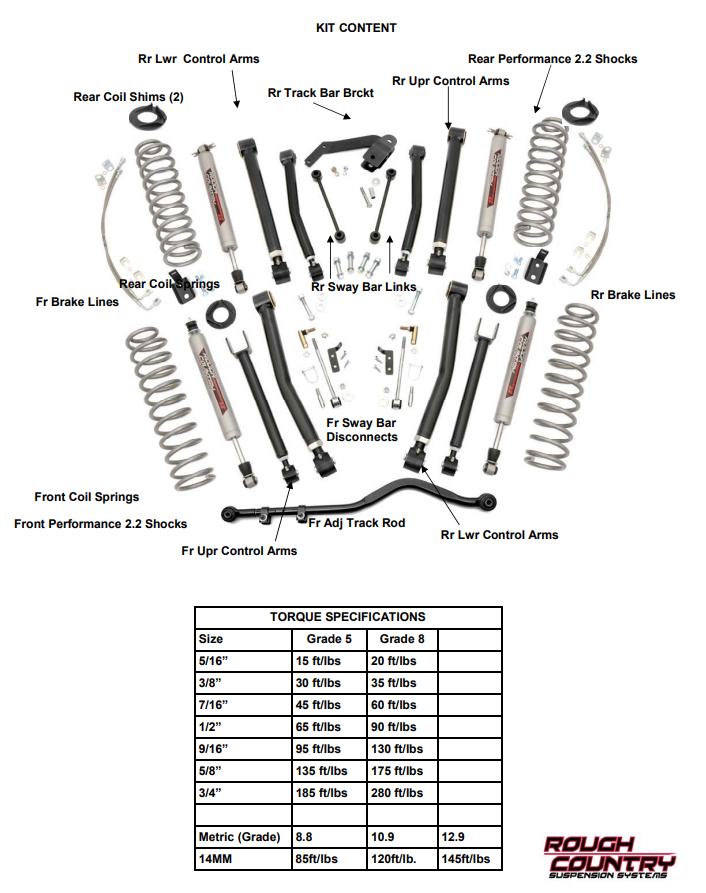
FRONT INSTALLATION INSTRUCTIONS
1. Prior to installing this kit, with the vehicle on the ground, measure the heights of your vehicle. This measurement can be recorded from the center of the wheel straight up to the top of the inner fender lip. Record the measurements.
LF:__________ ,RF:___________, LR:__________, RR:___________
2. Place vehicle in park and chock the rear wheels. Raise the front of the vehicle with a jack and secure a jack stand beneath each frame rail behind the front control arms. Ease the frame down onto the stands.
3. Remove the front tires/wheels, using a 19mm deep well socket.
4. Using a 21mm socket, remove bolt securing the front track bar to the frame. Retain stock hardware. See Photo 1.
5. Using a 18mm socket and wrench remove the bottom sway bar bolts. Using a 19mm socket and 18mm wrench, remove the top of the sway bar link. Retain hardware for later use. See Photo 2.

6. Remove the lower shock bolt using a 18mm socket and wrench. Using a 5/8” wrench unbolt the top of the shock and remove. See Photo 3. Retain the lower stock hardware.
7. Using a 21mm socket and wrench loosen the lower control arm bolts and a 18mm for the upper arms at the axle and frame, but do not remove.
8. On some models it will be necessary to remove the brake line bracket from the frame to allow the coils to be removed. Using a 10MM socket, remove the brake line bracket from the stock location.
9. Push down on the axle to allow room for the coils to be removed. Remove stock coil springs. Retain coil isolators.
10. Using a 21mm wrench, remove the bolts that secure the lower link arms to the axle.
11. Assemble the lower control arms with the adjustable end & adjust the arm to a length of 22 7/8” from center of hole to center of hole and tighten the jam nut using a 1 7/8” wrench. Install the adjustable end in the frame mount and the other end in the axle mount. Do not tighten arms in the mounts at this time. See Photo 4. The bend on the lower control arm should be facing inward to allow for the tires to achieve full lock to lock turning.

12. Remove the bolts securing the upper control arms to the axle using a 18mm wrench/socket. It will be necessary to cut out the passenger side upper bolt as shown in Photo 5 to remove the control arm.
13. After the stock control arms have been removed assemble the upper control arms with the heim joints. Adjust the arms to a length of 18 3/4” from center of hole to center of hole and tighten the jam nut using a 1 1/8” wrench. Install in the heim joint in the upper mounts with supplied 10mm x 80mm bolt and nut on the passenger side frame and stock hardware on the driver side.
14. Install the opposite end on the axle with stock hardware. Do not fully tighten at this time. See Photo 6.

15. Loosen the stock brake line from the metal line on the frame rail shown in Photo 7 using a 12 mm line wrench. A catch pan will be needed to catch the brake fluid.
16. Remove the line from the frame rail using a 10mm socket as shown in Photo 8. Remove the brake line from the caliper using a 15mm wrench and replace the brake line with the supplied stainless steel lines and brackets as shown in Photo 9. Reattach at the caliper with new supplied crush washers, tighten line and install the spring clip.
17. Be sure the factory rubber isolators are in place and install the front coil springs. Insert the coil into the upper tower first, followed by the lower seat. Be sure that the coils are rotated so that they seat properly. Raise the axle enough to hold the coil springs in place.
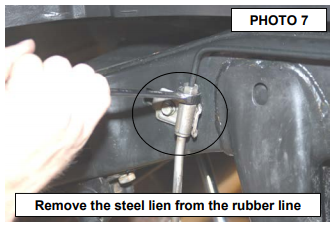

18. Install the bushings and sleeves from 1681bag2 in the shock box into the RCX shock absorber Part # 660585. Position the cup washer and stem bushing on the stem end of the shock and insert the stem in the upper shock tower. Install the remaining bushing and washer and loosely secure using the supplied nut. Tighten until the bushing swells slightly using a 9/16” wrench. NOTE: The RC 2.2 Series shocks are built to run piston down and have a built in bump stop thus a longer bump stop or bump stop extension is not needed with this kit.
19. Attach the lower end of the shock to the axle and secure using the stock hardware. Tighten to 80 ft/lbs.
20. Adjust the track bar to a length of 32 7/8” center of hole to center of hole. Install the new track bar into stock frame brackets using the stock hardware. Check to make sure the body is centered over the axle. Tighten the jam nuts on the track rod as shown in Photo 10 using a 18mm wrench. Torque all fasteners to specifications. It may be necessary to turn the steering wheel to align the track rod end with the axle.
21. This step will be performed on vehicles equipped with the optional front transmission skid plate only. One side at a time, using a 18mm socket remove the bolt that holds the cross member to the frame in front of the rear upper control arm. Insert 2 washers to each side supplied in 168XBag1, between the frame and cross member as shown in Photo 11. This will space the cross member down enough to allow driveshaft clearance at full flex. Tighten using the stock bolt. Repeat on opposite side.

22. Reinstall the front tires/wheels, using a 19mm deep well socket. Lower the vehicle to the floor.
23. On the front sway disconnects, assemble the supplied jam nut and end link on the sway bar link body. Adjust the sway bar to approx 11” for a 4” & 6” kit measuring end to end. Tighten the end and jam nut using a 18mm wrench.
24. Install the new sway bar link on the factory sway bar as shown in Photo 12 with the supplied 12mm Flange lock nut using a 16mm & 18mm wrench.
25. Install the new sway bar link on the sway bar bracket and swing up the assembly to the frame rail. See Photo 13. Remove the sway bar link from the bracket while holding the bracket in place.

26. Mark the holes to be drilled and remove the bracket from the frame. See Photo 14.
27. Drill the two holes per side using a 17/64” drill bit. See Photo 15. Be sure to only drill through the outside of the frame rail.

28. Install the frame bracket with the supplied 5/16” self tapping bolts (2 per bracket) using a 1/2” wrench as shown in Photo 16.
29. Install the supplied mounting pin as shown in Photo 17 and tighten using 19mm socket / wrench.

30. Swing the new sway bar link down and secure on the mounting pin using the supplied quick disconnect pin. See Photo 18.
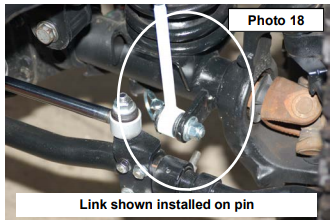
REAR INSTALLATION INSTRUCTIONS
1. Chock front wheels. Jack up the rear of the vehicle and support the vehicle with jack stands, so that the rear wheels are off the ground. Position a jack so it supports, but does not raise the rear axle.
2. Remove the rear tires/wheels, using a 19mm deep well socket.
3. Using a 21mm socket remove the track bar from the frame on the passenger side. Using a 21mm socket remove the track bar bolt at the axle and remove the track bar from the vehicle. Retain the frame side stock hardware for reuse.
4. Using a 21mm socket loosen, but do not remove the bolts securing the lower control arms at both the axle and frame.
5. On the rear of the vehicle remove the factory sway bar link using a 18mm socket and wrench on the lower. Remove the upper hardware using a 18mm wrench and a 19mm wrench on the ball joint end.
6. Using a 10mm wrench, unbolt the brake hose bracket at the frame. Retain hardware for later use.
7. Remove and discard the rear shocks using a 18mm wrench. Retain stock hardware.
8. Lower the axle enough to remove the stock coil springs.
9. Remove the upper control arms from the frame and axle using a 21mm OR 18mm wrench. Retain the upper flag nut in the frame and all other factory hardware. See Photo 19.

10. Assemble the heim joints in the upper control arms and . The rear upper heim joint is labeled as “Rear Upper” on the heim joint. Adjust to a length of 18 3/4” from center of hole to center of hole and tighten the jam nut using a 1 1/8” wrench. Install in the heim end on the frame with stock flag nut and the lower on the axle with factory hardware using a 18mm wrench. See Photo 20. Photo 21 showing rear axle install. Do not fully tighten at this time.
11. Using a 21mm OR 18mm socket remove the bolts securing the lower control arms at both the axle and frame. Passenger side lower shown in Photo 22. Remove the control arms and retain the hardware for reuse.

12. Assemble the heim joints in the new lower control arms and adjust them to a length of 20 1/2” from center of hole to center of hole and tighten the jam nut using a 1 7/8” wrench. Install the hiem on the frame and the opposite end on the axle with the factory hardware using a 21mm wrench. See Photo 23. Do not fully tighten.
13. Install the supplied rear coil shim as shown in Photo 24.

14. Install the supplied rear coil springs. Rotate the coils so that they seat properly in the coil seat, raise the axle enough to seat the coil springs.
15. Install the supplied 3/8” x 1” Bolts , washers & flange lock nuts in the factory holes. Do not tighten. See Photo 25.
16. Using the track bar bracket as a template mark & drill a 13/32” hole in the top of the original track bar mount.
17. Install using the .375-16 x 1” bolt, washer through the drilled hole from the top and secure with flange nut using a 9/16” wrench and socket. See Photo 26.

18. Insert the supplied sleeve, inside the factory track bar mount. Insert the supplied 14mm” x 80mm” bolt through the bracket, factory mount, and sleeve secure using the washer and nut. Do fully tighten. See Photo 27.
19. Tighten all track rod bracket hardware.
20. Install the factory track bar with the supplied 14mm x 75mm bolt washer & flange nut (upper hole) with the head of the bolt on the front by the coil spring. The passenger side mount on the track bar will be installed in a later step.
21. Locate the 4 sway bar link sleeves. Insert the supplied 1/2” inner diameter sleeves into the sway bar link bushings. Using the supplied .500-16 x 2.75” bolts, washers and nuts from 1681bag, install the sway bar links to the sway bar, and axle mount., and tighten using a 13/16” socket and 7/8” wrench. See Photo 28. Make sure the bolts are installed with the head of the bolt toward the tire as shown.

22. Install the supplied bushings and sleeves from 1681Shock bag2 to part # 660586 rear shocks. Install the RCX 2.2 series shocks using the factory hardware, using a 18mm socket for the top, and a 18mm socket for the bottom. Shaft end of the shock will be pointed down. The shocks have a built in bump stop. A longer bump stop will not be needed. See Photo 29.
23. Remove the rubber brake line from the steel line using a 12mm wrench as shown in Photo 30 and remove the brake line from the caliper using a 15mm wrench.

24. Install the new brake line bracket using a 10mm wrench and stock hardware to secure to factory location. Install the new brake line on the hard line and tighten. Install spring clip as shown in Photo 31. Install on the caliper with supplied crush washers, using a 15mm wrench.
25. Reinstall the rear tires/wheels, using a 19mm deep well socket
26. Lower the vehicle to the floor.
27. Using a 21mm socket tighten the front and rear lower control arms, both ends to 130 ft.lbs.
28. Using a 18mm socket tighten the front upper control arms, both ends to 80 ft.lbs
29. Using a 21mm socket tighten the rear upper control arms to 130 ft. lbs.
30. Make sure the body is centered over the rear axle and install the rear track rod bracket in the factory location on the frame with the factory hardware and using a 21mm wrench.
31. Adjust front draglink to center the steering wheel before driving by loosening the two bolts and turning the adjustment collar. See Photos 32 & 33.
IMPORTANT NOTE : The draglink must be adjusted to the center steering wheel BEFORE the vehicle is driven. Failure to do so will cause a computer error, odd handling, and poor performance.
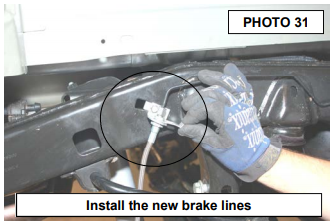

POST INSTALLATION
1. Confirm that the draglink was adjusted to the center steering wheel BEFORE the vehicle is driven. Failure to do so will cause a computer error, odd handling, and poor performance.
2. Check all fasteners for proper torque. Check to ensure there is adequate clearance between all rotating, mobile, fixed and heated members. Check steering for interference and proper working order. Test brake system.
3. Perform steering sweep. The distance between the tire sidewall and the brake hose must be checked closely. Cycle the steering from full turn to full turn to check for clearance. Failure to perform inspections may result in component failure.
4. Re-torque all fasteners after 500 miles and recheck after 1000 miles. Alignment must be checked by a qualified mechanic. Visually inspect components and re-torque fasteners during routine vehicle service.
5. Readjust headlights to proper settings.
6. Have a qualified alignment center realign the front end, to the factory specifications immediately.
- Caster preferred 4.6 degree range ,- 1 degree
- Camber preferred –0.25 degree range ,- 0.63 degree
- Toe-in preferred 0.15 degree range ,- 0.15 degree
MAINTENANCE INFORMATION
It is the ultimate buyers responsibility to have all bolts/nuts checked for tightness after the first 500 miles and then every 1000 miles. Wheel alignment steering system, suspension and driveline systems must be inspected by a qualified professional mechanic at least every 3000 miles.
Thank you for purchasing a Rough Country Suspension System.
